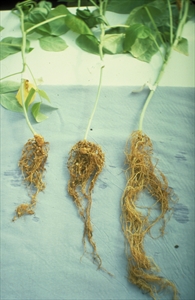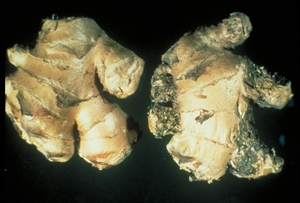- Worldwide distribution. In tropics and sub-tropics. Several types. On many vegetables (beans (see Fact Sheet no. 127), capsicum, carrot, celery (see Fact Sheet no. 254), cucumber, eggplant, ginger, lettuce, potato, tomato and yam), fruit crops (melon, papaya, pineapple), ornamentals, and weeds. Important pests.
- Plants become yellow, stunted, and wilt. Characteristic galls on the roots ('knots').
- Eggs laid in soil, worm-like young females enter the roots to feed and lay eggs, causing cells to swell.
- Spread occurs in soil water, on tools, footwear and machinery, and over long distances in plant roots, especially in the trade in vegetable seedlings and ornamentals.
- Cultural control: resistant varieties; pasteurised soil or use soilless mixes; crop rotation; fallow periods (4-6 months); soil solarisation (4-6 weeks); manures and composts; marigold fallows.
- Chemical control: none recommended.







